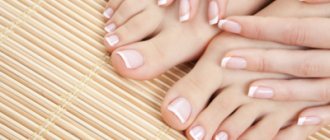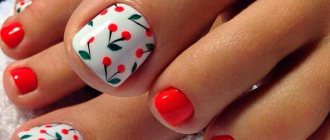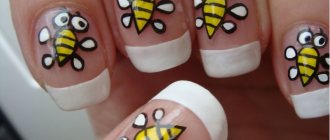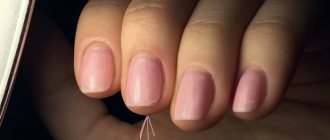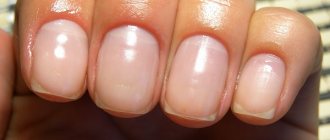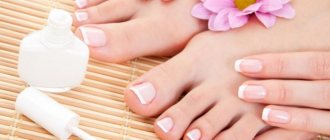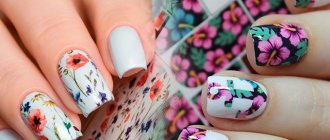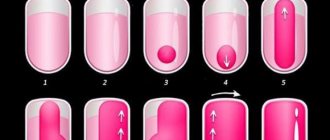How to soften toenails with fungus?
If thick nails are one of the symptoms of the disease, you need to cure it.
- If you have a fungus, you need to deal with its spores. Miconazole and similar antifungal agents are used in treatment:
- Anemia is treated with vitamin complexes. For example, for iron deficiency anemia, iron-containing drugs are prescribed.
- In case of allergies, allergens are identified and antihistamines are used.
If problems with toenails in an elderly person are caused by tight and uncomfortable shoes, you need to choose a suitable pair.
At home, you can apply compresses, foot baths, use oils and ointments to soften toenails, and polish them. Such procedures will help improve the appearance of your nails and get rid of pain. After these procedures, soft nails can be trimmed or filed.
The fungus must be treated as soon as its first symptoms are detected. Microorganisms settle under the nails and grow their mycelia in all directions. This is how neighboring nails are damaged. The infection progresses from the exposed ends to the roots. The worse the nail growth, the faster the disease spreads. For this reason, onychomycosis occurs more often in old age.
For the development of microorganisms, nutritious, moist conditions are required. An elderly person's feet should always be clean and dry - if foot hygiene is carefully observed, fungus will not develop.
With fungus, the nails become rough, peel, acquire uneven edges, and become yellow-brown in color.
Treatment of fungus is complex. The patient is prescribed fungicidal medications, as well as antifungal agents for nails. They may contain various acids: lactic, benzoic, salicylic, as well as sulfur and thymol. These are effective helpers in the fight against fungal infections.
Treatment procedures must be regular. Treatment can be long and continues until the nails are renewed and healthy. To do this, you can contact a boarding house for pensioners in the Leningrad region, where they will provide all the necessary qualified assistance.
Ointments and creams
You can buy ointments at a pharmacy or make them yourself. They should be used after processing and preparing the nails.
- Salicylic ointment. Another popular remedy for treating fungus. Before applying it, you need to make a steaming bath with manganese, soap and soda. A 5% ointment is applied after a foot bath twice a day in the morning and evening, and on top is a bandage that is kept in place for an hour. After the specified time, the remaining product is removed using a soft cloth.
- Ichthyol ointment or Vishnevsky Ointment is a good helper for ulcers and ingrown nails. These ointments are applied in the same way as salicylic acid.
- Vitamin cream. You can take any nourishing cream with a fatty base, add 1 teaspoon of olive oil, vitamins A and E. This mixture should be applied to rough areas daily, and after absorption, file off the soft areas. This method is used at the very beginning of thickening of toenails.
- Uroderm ointment. The active ingredient urea softens keratinized parts. Apply thin layers twice a day. For fungus, apply the product for half an hour before using the local preparation.
- Kanespor. This antifungal kit also helps treat thickened nails in the elderly. Once a day, nails are treated according to the instructions. Within 7-14 hours, the nails become completely soft, then they are removed, and the wounds are sealed with medicinal plasters. The patches must be changed daily for fresh ones.
- Nailitis. A nail preparation that will help soften the nail plates and cut them without pain. Before use, you need to make a bath of soap and soda, apply only to the nails, without touching other areas of the skin. Cover with a band-aid and leave for 3-4 days. After the specified time, you need to peel off the patch, take a steam bath and file off the soft parts of the nails.
- Nogtimycin. The drug contains urea and salicylic acid, which help effectively fight the fungus. Thanks to this combination, you can easily get rid of a diseased nail.
If the nail plates are very hard and the nail on the big toe has turned yellow, this indicates a fungal infection. Fighting the disease with conventional creams and various folk methods is quite stupid, since the fungus tends to quickly progress and affect healthy areas. This disease can also be transmitted to other people.
Treatment of fungus involves the use of medications. The most effective of them:
- Dimexide. You can use both ointment and solution. The medicine has a powerful antibacterial effect. It helps to quickly get rid of infection and achieve the desired softness of the nail plates. Cost of the medicine: from 110 rubles.
- Exoderil. A medicinal liquid with an antibacterial and restorative effect. The drug relieves itching, kills pathogenic microorganisms and accelerates the growth of healthy nails. Price: from 480 rubles.
- Nizoral. The product fights almost all types of fungal bacteria. Available in cream form. The drug is not recommended for use by pregnant and lactating women. Cost: about 140 rubles.
Dimexide will help soften the nail plates
You can also soften fungal nails at home using traditional methods. Foot baths, special compresses, as well as ointments prepared with your own hands according to folk recipes will help with this.
Foot baths
Homemade baths help soften the nail plate. After such procedures, it is easier to shorten nails. Also, such manipulations help prepare the surface for the application of certain pharmaceutical drugs. The following bath compositions are effective:
- Soap and soda. Take 3 tablespoons of soda and the same amount of tar soap shavings. Add the mixture to heated water (5 liters), then soak your feet in the mixture for 20 minutes. The procedure is recommended to be carried out daily for a week.
- Hydrogen peroxide. Add 5 tablespoons of the drug to 2 liters of hot water. Keep your feet in the solution for 15 minutes. Carry out the procedure every other day, then apply cream to your feet. The drug helps fight fungus on the feet, softening not only nails, but also calluses and corns.
- Essential oils. Such compositions help soften nails and also have antifungal and anti-inflammatory effects. Extracts of patchouli, lavender, tea tree and eucalyptus work effectively. You should add only 3-5 drops of ether to heated water (2-3 liters). You need to keep your feet in the bath for about 20 minutes.
- Vinegar baths. Add 250 ml of vinegar to 2 liters of water. Keep your feet in the solution for 10-15 minutes.
- Herbal collection. You can use sage, St. John's wort, chamomile and celandine for baths. Add the products in equal parts to boiling water, at the rate of 4 tablespoons of raw materials per 2 liters of liquid, and leave for 1 hour. Then strain the infusion, add another 2 liters of warm water and soak your feet in it for 20 minutes.
Foot baths with different products If for some reason it is not possible to take a foot bath, you can resort to softening compresses. This is an equally effective method that is suitable for older people or those patients who cannot undergo the standard procedure due to other diseases. Better compresses:
- Using aloe. You need to tear off a leaf from the plant, wash it thoroughly and cut it. Then apply the inner side to the nail plate on the toes and secure with cling film, adhesive tape or bandage. It is advisable to do such compresses at night.
- Vinegar based. Soak a cotton pad in 9% apple cider vinegar and apply it to the nail affected by the fungus. Wrap the finger with a bandage or film on top and put on a sock. The compress must be removed after 4 hours. Afterwards, rinse your foot with clean water and apply nourishing cream.
- Tea mushroom. Apply a piece of mushroom to the affected nail, then secure with a bandage. Keep kombucha for 8-9 hours.
Self-prepared ointments also help soften toenails with fungus. The most effective recipes for cooking yourself are given below:
- You will need 5 drops of Dimexide and the same amount of essential oil. The basis is the usual baby cream (1 tablespoon). You need to mix all the ingredients to obtain a homogeneous consistency. Apply the mixture to the nail in a thick layer. After keeping the product on the nail plate for 1 hour, you can further steam your foot in a hot bath.
- Grind a medium-sized onion and a head of garlic. Add a little ghee to the mixture. Apply the prepared mixture while warm to your nails and wrap them in film. If a fungal infection affects the nail plate only on the little finger, then the ointment should be applied to only one appendage. It is recommended to keep the composition on the nail throughout the day. In the evening, steam your feet in water and remove thickening using special tools.
To remove the layer of stratum corneum from the toenail plate that has been affected by fungus, you must first soften the surface. To do this, you can use both pharmaceutical preparations and home-made formulations. This step should not be skipped, because rough thickened nails will flake and crumble even more when you try to shorten them. There will also be an increased risk of damage to nearby tissues and the spread of fungal infection.
It is very difficult to get rid of such a chronic pathology as onychomycosis. The nail affected by the fungus takes on a characteristic appearance: it thickens, becomes lumpy, opaque, and takes on a yellowish or gray tint.
For successful treatment, it is important that antifungal drugs penetrate as deeply as possible into the thickness of the nail plate. For this purpose, nails need to be regularly trimmed and their top layer filed off, which is quite problematic if the nail plate is excessively thick.
Proper care of fingernails. Manicure for an elderly person at home
It is easier for an elderly person to care for their fingernails than their toenails. But it is not always possible to do this properly. Poor vision, poor coordination of movements interfere, and dizziness may occur due to prolonged eye strain. Therefore, often old people cut their nails rarely and quickly, in a word, poorly, which can lead to unpleasant consequences.
The nail plate on the hands, as well as on the toes, becomes harder. But it happens the other way around, especially in women, when a problem such as dystrophy of the nail plate occurs. From constant external influences of water, chemicals, from the use of nail polishes and liquids for removing them, fingernails become thinner, become brittle and are destroyed. In addition, with age, fingernails acquire a yellowish tint.
To solve these problems, you should resort to baths from infusions of medicinal herbs, which we have already described above. If an elderly person is not prone to allergies, then you can make baths with the addition of essential oils - lavender, tea tree, rose, eucalyptus. Such procedures will not only steam your hands, but also moisturize them, nourish them and have a regenerating effect.
Lemon is used to whiten the nail plate. You can massage each nail with a crust or make a bath with the essential oil of this citrus. Of course, it will not be possible to completely remove the age-related yellowness of the nail, but you will definitely be able to give it a fresh look.
After a pleasant water treatment for your hands, all that remains is to carefully trim the old man’s nails, file the pointed ends with a file and process the cuticle. Finally, you can use a nourishing hand cream. Fingernails can be damaged by a fungal infection. If you notice such a disease in your elderly relative, consult your doctor to prescribe treatment. Old people themselves, as a rule, ignore the disease against the background of diseases that worry them more.
If it is not possible to solve problems with nails at home, then an elderly person can be shown to a highly specialized doctor - a podiatrist. It is within the competence of a doctor to perform a medical pedicure, which an ordinary master has the right to refuse. After all, most of them accept clients without any nail diseases and do not know how to properly treat problem nails.
You can cope with all nail diseases even in old age. The main thing is not to neglect them and start treatment on time. Remember that the aesthetic appearance of fingernails and toenails will contribute to the good mood of an elderly person, bring pleasure and give a sense of self-confidence.
Softening of toenails in older people
How to steam toenails with fungus using special preparations? To treat complex cases, it is best to use pharmaceutical products that have a complex effect. They not only soften the nails, but also have a detrimental effect on the fungal microorganisms themselves, heal the nail plates and promote their rapid regrowth.
Dermatologists recommend using special liquids, ointments or varnishes to soften and remove nails affected by fungus.
The most popular antimycotic agents:
- Dimexide. A liquid with a specific “garlic” odor, which is widely used to treat the initial stages of onychomycosis. The advantages of Dimexide are its availability, low cost, and ease of use. Disadvantages include the need for long-term use, unpleasant odor, side effects - itching and irritation of the skin of the fingers.
- Exoderil. A popular antimycotic product available in the form of a solution or nail polish. The drug effectively softens deformed nails and successfully fights fungi and pathogenic bacteria. The disadvantage of this product is its high cost.
- Nailitis. The most famous nail remover, the main active ingredient of which is stearic acid. This is a relatively inexpensive remedy that can quickly and painlessly remove the affected nail plate, however, it does not affect the fungus and should only be used in combination with other antifungal drugs.
- Uroderm. Urea-based ointment that can remove nails affected by mycosis. When using the product, it is important to carefully protect the skin adjacent to the nail to avoid irritation and peeling.
- Tinedol. A mild product containing glycerin, wax, vitamin E and essential oils. The ointment is pleasant to use, causes virtually no side effects and is effective against fungus.
- Batrafen. Varnish containing ciclopirox. Before using the product, it is important to thoroughly wash your feet and file the top layer of your nails with a nail file. After 2-3 applications of varnish, the affected areas of the nail plate will be completely ready for removal.
- Keratolytic patch. A preparation impregnated with a special substance, under the influence of which the nail softens. It is applied for 2-3 days and is suitable for removing nails, especially suitable for the elderly.
The reasons for changes in toenail color, thickness and shape are varied:
- Fungal infection, otherwise known as onychomycosis. The nail becomes duller, lumpier, breaks and gradually peels off from the nail hole.
- Psoriasis. Leads to rash and peeling on the plates and epidermis.
- Squamous lichen. Symptoms: thickening, ribbing, crumbling of nails.
- Impaired blood flow in the nail bed. Because of this, the plate becomes thicker and its structure is disrupted.
- Flat feet and injuries.
- Regular contact with chemicals.
- Chronic diseases, metabolic disorders.
- Wearing tight or uncomfortable shoes. Deformation of nails for this reason occurs more often on the big toes.
- Accumulation of salts in the body with age. This process also causes thickening of the nails because some of the salts will be deposited in them.
- Stress and dietary disorders. Lack of nutrients due to overeating or dieting, strong feelings, hard work - these and similar factors can affect the health of the body in general and nails in particular.
In order to soften the plate, you can use baking soda paste:
- Take a tablespoon of baking soda and dilute it with water until it becomes mushy;
- Apply the mixture generously to the affected nail;
- Squeeze lemon juice (1 tsp is enough);
- Spray the area treated with soda with it - a characteristic reaction will occur, a slight burning or tingling sensation may be felt.
After about 3 minutes, when the reaction has passed, the product is washed off, part of the plate is removed and an antimycotic drug is applied.
The next method is more labor-intensive, but quite effective - this is a multi-component ointment:
- You will need - ghee, grated onions and garlic, aloe pulp, beeswax (all proportions are equal);
- The ingredients are mixed, set to simmer on the fire (2 minutes), beeswax is added last and boiled for about another minute;
- The ointment must cool, only after that it is generously applied over the nail;
- The finger is wrapped in a cabbage leaf, polyethylene, and secured with a bandage;
- The duration of the procedure is 8-12 hours.
Before applying the ointment, it is recommended to first steam your feet a little, this will increase the effectiveness of the product.
In addition to unconventional methods, there are special medications that help soften the nail plate. After using them, you can easily remove the entire affected part of the nail.
These are products such as Onychoplast, Nogtimycin or Nogtivit. They have keratolytic activity (soften the plate and exfoliate it layer by layer). The task of these drugs is to open free access and allow antifungal drugs to penetrate deep tissues to combat the causative agent of the disease.
Use medications in accordance with the instructions.
Thickening of the nail plates in older people occurs due to deformation of the feet and salt deposition in the body. An old person needs to carefully care for their feet so that their nails do not grow into the skin.
It is best to use the following methods:
- Applying compresses with aloe. This plant can moisturize even very hard, thick and old nails. Compresses can be made directly from the leaves of indoor aloe. For this procedure, you will need to place pieces of the plant on the nail plates and secure with adhesive tape.
- The use of celandine and iodine. It is necessary to mix these ingredients and apply them to keratinized nails. The mixture should be kept for 15-20 minutes.
- Using ultra-nourishing gel. Not every softening cream can cope with hard nails of pensioners. For these purposes, only deep-acting agents can be used.
In pharmacies you can purchase compounds that can soften nails and have a detrimental effect on the fungus. They differ from each other in release form, cost and effectiveness.
Salicylic acid
The simplest and most effective drug. Available in ointment and liquid form. An ointment for softening toenails with fungus is more effective. You can buy it at any pharmacy for about 30 rubles.
If you have a fungus, you must first steam your feet in warm water, to which you first add a little soda. Then wipe your feet dry with paper towels and begin treating your nails. Use a cotton swab to grab the ointment and apply a thick layer to the plate affected by the fungus, without touching the surrounding skin in the process. Cover the top of the finger with cling film and leave for 30-40 minutes.
After the specified time, the nail plate will become soft and easier to handle. For this you should use a disposable nail file and clean nail clippers.
Nogtimycin
This cream fights fungal infections and can soften even very thick nails with onychomycosis. The average price in pharmacies is 130-150 rubles.
First, steam your feet, then apply Nogtimycin cream to the affected plates. The cream should not come into contact with the skin. Then cover your fingers with a regular band-aid for 3 days. Finally, remove the patch, re-steam your feet in warm water, and you can begin treating already soft nails. Nogtimycin can even soften the nail on the big toe, which can be difficult to work with in onychomycosis.
Salicylic acid and Nogtimycin
Nailitis
The drug was created to soften and treat the nail plate with a fungal disease. First, steam your toenails, then apply the product to the affected appendages, cover with a band-aid and wait 3 days. After the specified time, removing the nail will be simple and painless.
In pharmacies you can buy both Nogtivit cream (200 rubles) and nail polish (620 rubles).
Uroderm
The drug contains urea, so it effectively softens even the thickest and hardest growths on the nails. You need to apply a thin layer of the drug to the nail plate twice a day - morning and evening. You can also make compresses with Uroderm at night. The drug is sold in tubes of 10 g (150-160 rubles) and 35 g (320-340 rubles).
You should not select an emollient yourself. It is recommended to consult a doctor about which pharmacological product is suitable for a particular case.
Softening nails with Nogtivit and Uroderm
Foot baths
Aloe contains beneficial elements
Elderly people are also advised to wear only comfortable, flat shoes. If the nail begins to grow into the skin, you will need to visit a doctor, since such a problem can lead to an inflammatory process. At home, you can steam your legs and try to remove the appendage.
Medications, as well as traditional methods, help restore the softness and elasticity of nails. In pharmacies you can buy a universal softener that will quickly deal with the problem. It should be borne in mind that infectious diseases cannot be cured with such folk remedies and medications.
It is highly not recommended to use folk recipes based on onions or garlic. Such components can cause severe irritation and peeling of the skin.
Softening oils
You can use absolutely any natural oil. For these purposes, jojoba, shea tree, lavender or almond extracts are best suited. Oils should be added to nourishing creams and baths. Such components perfectly nourish the feet, in addition, they saturate the skin with vitamins. It is highly not recommended to use oils individually; for a good effect, it is enough to add 2-3 drops of the product to a ready-made care product.
Natural oils saturate the skin and nails with vitamins
Water and soda
Causes of hard and stiff nail plates
Nails can harden for various reasons, but one of the most important is age-related changes. And the older a person is, the thicker his nail plates are. In addition, there are other factors that appear in both adults and older people.
In adults
In adults, nails harden for the following reasons:
- Due to improper hygiene.
- When wearing uncomfortable and uncomfortable shoes for a long time.
- Due to an incorrectly performed manicure.
- After suffering injuries and bruises of the nail plate.
- For fungal infection.
- With a lack of useful microelements and vitamins.
- When eating unbalanced food.
- In the presence of bad ecology.
- Under stress.
If at least one of the above problems appears, it is necessary to eliminate it as soon as possible, otherwise it can lead not only to hardening of the nails, but also to other serious diseases.
In the elderly
In older people, hardening of nails occurs in the following situations:
- For psoriasis.
- For endocrine disorders.
- For cardiovascular diseases.
- If there are a large number of allergens in the body.
- For various pathologies of the liver and kidneys.
- When treated with certain drugs for a long time.
- With vitamin deficiency.
- With poor nutrition.
- When living in an area with poor ecology.
- With constant depression.
Hard nails are a signal from the body that indicates that something urgently needs to be done.
Conclusion
Having learned how to steam toenails with fungus, you should not forget that this procedure is auxiliary. It can produce a temporary effect, but it can defeat mycosis only at the very initial stage. Therefore, steaming the toenails is mandatory before applying the medicine, but not instead. Also note that even traditional medicine recipes may have their contraindications. For example, if you are prone to atopic dermatitis, be careful when taking baths with iodine or essential oil - these substances most often cause allergic reactions - hives, itching.
If you have extremely dry skin, use vinegar baths with caution, or lubricate the skin after the procedure with a rich cream, avoiding the area of the nail itself.
Chamomile bath
Chamomile is an inexpensive and effective remedy with virtually no contraindications. By taking a foot bath and using chamomile tea, you can not only steam hardened nails, but also disinfect your toes and feet in general.
A foot bath for pedicure with chamomile is prepared as follows:
- Boil 1 liter of water.
- 6 tablespoons of chamomile extract are poured into the prepared water.
- They all infuse for two hours, then filter.
- Then everything boils again.
- Finally, the broth is cooled to an acceptable temperature and used for its intended purpose.
The feet are lowered into the bath and left for 20 minutes. By adding boiling water, you can extend the cooking time. Hard nails will become soft and flexible for cutting.
Foot baths
The most popular way to soften hard toenails is with hot foot baths. After the procedure of steaming your feet, the nail plates soften and are easy to trim.
For better results, you can do one of the following baths at home:
- Soap and soda bath. Softens, relieves inflammation, has an antimycotic (antifungal) effect. You will need soda (3 tbsp.) and tar soap shavings (3 tbsp.). Warm 5 liters of water (not higher than 50C), add a soap-soda mixture, soak your feet for 20 minutes. This and all subsequent procedures are recommended to be performed every day for a week.
- Essential oil. The product helps soften the plate and has anti-inflammatory and antimycotic activity. It is best to use extracts of tea tree, patchouli, eucalyptus, and lavender. It is enough to add 3-5 drops of ether to warm water (2-3 liters) and lower the legs there for 20 minutes.
- Hydrogen peroxide. The product fights fungus, softens rough nail plates, calluses, and corns. Pour 5 tbsp into hot water (2 liters). l. peroxide. The procedure takes no more than 15 minutes. It is recommended to perform manipulations every other day, after which lubricate the feet with cream.
- Vinegar baths. The product softens nails and also fights the causative agent of the disease. Pour a glass of vinegar (250 ml) into warm water (2 liters), dip and soak your feet for 10-15 minutes.
- Herbal collection. Chamomile, sage, celandine and St. John's wort (1 tablespoon each) pour boiling water (2 liters), leave for about an hour. Strain the infusion and add the same amount of warm water. Carry out the procedure for about 20 minutes.
The time for bathing procedures is 15-20 minutes, until the water cools completely. During this time, the nails will become soft and can be easily cut off. It is worth noting that it is not recommended to add sea salt to the nail softening bath, as this procedure helps strengthen the nail plate.
This method is the simplest and most accessible for softening nails. To create the best effect, the procedure should be carried out daily for 20-30 minutes.
The most common baths contain:
- Infusions of medicinal plants (calendula chamomile).
- Glycerol.
- Vinegar.
- Baking soda.
- Sea or table salt.
- Essential oils.
- Iodine and other antiseptics.
Here are the recipes for the most popular baths for treating nails affected by fungus:
- Soda-soap composition. Grate 3 tbsp on a coarse grater. l. tar soap, mix the resulting shavings with 3 tbsp. l. baking soda. Then dissolve the resulting mixture in 5 liters of water, preheated to 50–55 degrees. You should steam your feet in such a bath for 20 minutes, after which you need to wipe them dry with a clean terry towel and proceed to further processing - trimming and filing thickened nails.
- Herbal bath. For this procedure, you need to pour 2 liters of boiling water into 5 tbsp. l. a mixture of chamomile, St. John's wort, celandine and sage, taken in equal proportions. Leave for an hour, strain and dilute with warm water. The duration of the procedure is 20-30 minutes (until the water cools down).
In addition to the fact that the procedure helps soften the nail plate and calluses, it helps eliminate other manifestations of a fungal infection, such as itching, burning and an unpleasant odor.
How to treat nails affected by a fungal infection
Fungus causes the nail plate to become hard, layered and wavy. The color changes to a characteristic yellow-brown. The fungus develops from the edge of the plate to the root. Since older people's nails grow slowly, they are more susceptible to this disease. If you notice the first symptoms of mycosis, begin treatment immediately. If nail fungus in older people invades new territories, spreads to healthy fingers, and affects the skin, then more radical measures are needed than compresses or baths to get rid of the infection. You should not cut nails affected by fungus without prior preparation . The affected plates may burst, forming a painful crack, if they are processed without first softening them. An infected nail should not be pulled off. This is fraught with infection, the consequences will be even worse. After softening, the damaged area should be cut off as much as possible, and the edges should be lightly sanded with a nail file. Medicines should be applied exactly after treatment so that they penetrate deeper into the nail plate. To prepare the feet of an elderly person affected by fungus for care, add disinfectants to a bath of water: chamomile decoction, iodine, potassium permanganate, soda. You can soften the skin with antimycotic ointments (sulfur, salicylic, benzoic and lactic acids). They contain substances that can stop and eliminate fungal infection.
Fungicidal agents for the treatment of nail fungus
To completely get rid of a fungal infection in the nails of an elderly person, it will take several months to a year.
Recovery depends on many factors. In pharmacies you can purchase effective medications to combat fungus. The most widely used for onychomycosis are:
- Varnish "Loceryl" . The varnish is applied once or twice a week to a degreased and treated nail plate. The duration of the course of treatment is long – up to a year. The drug is effective and justifiably expensive. The cost is about 1500 rubles.
- 5% salicylic ointment . Will help in the initial stages of infection. Gradually and methodically softening areas with fungus with this remedy, they can be removed after treatment. But for this, the ointment will have to be used several times a day as a compress after a bath with hot water and soda or potassium permanganate.
- “Canespor” set (includes a set of plasters, an antiseptic drug and a scraper). The product should be used frequently, several times a day, gradually softening the nail plate. The duration of the procedures is one to two weeks. Then you can remove the infected layer. Cover the hole with adhesive tape. Replace it every day with a new one.
- "Exoderil" is a powerful drug. It has dosage forms such as solution and ointment. Duration of therapy is from two to four weeks.
Fungal disease is difficult to treat. A set of measures will be required. Inside - fungicidal preparations, outside for treatment - lotions, creams and ointments. The fungus develops in a moist and warm environment. The person himself serves as food for them. Therefore, the first important condition is careful foot hygiene. After treatment, prevention should become a habit.
Read the material on the topic: What should be the proper care for the elderly
How to soften toenails for cutting?
For a pedicure, you must treat your feet and soften your nails. Only after this should you use special scissors.
Foot softening is carried out in three main stages:
- Preparing the bath. The water should be purified and warm; you can add 5-7 tablespoons of chamomile solution to it. It is advisable to let the bath sit for 1.5-2 hours.
- Steaming the feet. First, you need to dip your feet in the prepared water, and then slowly add boiling water. You should monitor the temperature of the liquid so that the person does not get burned.
- Treatment of the nail plate. The already quite soft nail needs to be additionally covered with moisturizer.
After performing these procedures, dry nails can be trimmed and varnished. Many experts recommend using a Scholl file, as it helps make the skin smooth and removes dead skin particles.
Apply polish to dry nails
Prevention: how to keep your nails healthy
- Once a week it is useful to take foot baths with herbs.
- Get a pedicure at least once every two to three months from a good specialist.
- Do not cut your nails too short and cut them in straight lines without trimming the ends. This is the prevention of ingrown nails. The corners can be filed with a file.
- For cutting, use tools: clippers or nippers.
- Elderly people should not add salt to the solution - it makes the nails harder.
- Elderly people should not cut rough and thick nail plates without first steaming them. Dry nails may crack or come off.
- At the first unhealthy symptoms, consult a doctor. Nail problems are often a symptom of major internal diseases.
- You must wear rubber flip-flops to the communal pool, sauna and beach.
- Wipe your feet dry after showering. Keep them dry and avoid fogging.
- Do not try on or wear another person's shoes. Wear your comfortable low-soled shoes.
- Change socks regularly. Keep your shoes clean and treat them with antibacterial agents if necessary.
To keep your nails healthy, you need to use a comprehensive treatment: lotion/ointment and a preparation for internal use. Careful hygiene and use of baths are also required. An elderly person needs regular monitoring of the condition of his legs. These tips will help keep the nails of an elderly person beautiful and healthy.
Effect of antifungal patches
Antifungal patches are convenient for use by patients of all ages. It is enough to stick the patch on the infected nail, check the strength of its adhesion and walk like this for 24 hours. If the nail is not in a bad state, you can remove the patch 5-6 hours after gluing. Then the patch must be removed, and the nail plate must be additionally treated with ointment or varnish.
More on Med-Gribok.Ru:
Treatment of nail fungus with birch tar
Powered by Inline
Homemade ointments to soften nails
You can cure an ingrown toenail with various ointments that you can prepare at home. Such ointments soften the nail plate well and relieve inflammation between the nail and soft tissues. A good and quick result can be obtained if you use an ointment made from onions, wax, garlic and butter. To prepare you will need: 1 small onion, aloe leaf, 1 clove of garlic, 20 g melted butter and 10 g wax. All ingredients need to be crushed, add wax and oil and cook over low heat for about 5 minutes, stirring regularly. Afterwards, the finished mixture needs to be cooled and applied to the nail, you can make compresses. After applying the ointment, wrap your toe in plastic, put on a warm sock and leave it overnight.
You can cure an ingrown toenail with ointments, which, if desired, can be quickly prepared at home. A good result can be obtained if you use an ointment made from onions, wax, garlic and butter.
This ointment is recommended to be applied after any bath, which will enhance the effect of each other and soften the nail in a short time, trim the edges, thereby curing onychocryptosis.
Moisturizing cream. If the nail grows into the skin and there are difficulties with its removal, you can use a regular moisturizer, which should be applied to the skin between the nail and the nail plate itself. You need to apply the cream after bathing or showering. It is recommended to do this procedure every other day; you can alternate with compresses or baths. For a hard nail plate, it is better to choose cosmetic creams that contain herbal ingredients, as well as vitamins A and E.
Steaming nails in the bathroom
In order to increase the effectiveness of treatment, it is important to follow a number of simple rules. It is best to steam your nails at night, before going to bed, immediately before applying antifungal ointment or cream.
Algorithm of actions during the procedure:
- Prepare a solution for steaming (add soda, sea salt, essential oils or herbal decoction to the water).
- Pour several liters of warm solution into a shallow bowl.
- Immerse your feet or hands in water and hold for 20 minutes until cool.
- Dry your feet thoroughly with a terry towel.
- Trim or file your nails.
- Apply an antifungal drug.
After finishing the foot bath, it is very important to wipe your feet dry, special attention should be paid to the spaces between the toes, since it is in them that foci of fungal infection are most often localized.
How to trim rough nails
Several ways to soften your toenails for cutting: you can steam them in baths for 15-20 minutes, adding boiling water to the cooled water.
Hard nails soften and are easy to trim. You cannot add salt to the water, it makes them even harder. Recipes for baths to soften nails:
- add 1 tsp per 1 liter of water. soda, ammonia and liquid soap;
- you can add 5 drops of essential oils to the water: lavender, eucalyptus, rosemary, lemon or tea tree, they have disinfectant properties that effectively soften the plate;
- bath with soda and tar soap;
- bath with chamomile. Brew 5 tbsp. l. pharmaceutical chamomile in 2 liters of water for 5 minutes;
- bath with celandine. 4 tbsp. l. Brew herbs in 1.5 liters of water for 5 minutes.
It is necessary to cut steamed nails in an even line to avoid problems such as ingrown nails. After trimming, lubricate your legs with nourishing cream.
Compresses
Many patients treat their nails with compresses. In order for the nail plate to become soft and pliable, they should be used daily for 3-5 days.
Compresses based on:
- Vinegar. A cotton pad must be moistened in a 9% solution of table vinegar, squeezed thoroughly, and applied to the affected nail. Wrap with plastic wrap and insulate the top with a sock. Keep the compress for 20-30 minutes.
- Aloe. This medicinal plant is widely used for almost all diseases. To treat onychomycosis, apply an aloe leaf cut lengthwise to the nail, wrap it with a band-aid or wrap it in cling film. Leave overnight.
- Soda. To prepare a soda compress, you need to dissolve a small amount of baking soda in water until it becomes pasty, apply the mixture to the nail and sprinkle with lemon juice. The bubbling mixture should be left on the nail for 3-5 minutes, then rinsed off and treated with an antifungal agent.
The following remedies will help soften a nail affected by fungus:
- Vinegar. It disinfects and perfectly softens the plate. A cotton swab soaked in 9% vinegar is applied to the affected area, wrapped in polyethylene, and worn over the sock;
- Vinegar vegetable oil. Both ingredients are mixed in equal proportions, soaked in gauze cloth and applied to the affected nail. They also wrap it in film, put on socks, and leave it overnight;
- Tea mushroom. Softens the plate, removes unpleasant symptoms. Cut off a piece of the mushroom, apply it to the nail, and secure it with a bandage. In the morning, remove and treat the affected area with water and vinegar. The result is noticeable after the first procedure;
- Aloe. It has an antiseptic, anti-inflammatory, softening effect. Cut the sheet lengthwise (after removing the thorns) and apply the cut to the nail, secure with polyethylene and a bandage, and remove in the morning.
In the same way as aloe, you can use the leaves of golden mustache or Kalanchoe.
Important!
Before carrying out any manipulations, make sure that the product you choose will not cause allergies; to do this, apply it to the inside of your elbow and rinse off after 15 minutes. If there are no unpleasant symptoms (rash, itching, severe redness), feel free to use folk medicine.
If an elderly person is unable to take a foot bath due to illness or other reasons, then you can soften a thick toenail at home using compresses:
- Compress using aloe. Wash the leaf torn from the plant and cut it. Apply the inner part to the nail. Secure the leaf with cling film, bandage or adhesive tape. It is better to apply this compress at night and remove it in the morning.
- Tea mushroom. Place a piece of mushroom on the problem area and secure with cling film or bandage. After 8 hours, the bandage can be removed. Trimming your nails after this procedure will be easy.
- Vinegar and vegetable oil. Both ingredients are mixed in equal proportions, soaked in gauze cloth and applied to the affected nail. They also wrap it in film, put on socks, and leave it overnight;
- With vinegar. Soak a cotton pad in apple cider vinegar or 9%. Apply to the damaged nail and wrap your foot with cling film, wearing a warm sock. After 4 hours, you can remove the compress. Next, wash your finger with clean water and apply nourishing cream.
What to do with an ingrown toenail
Do not lift it or cut out the ingrown edge, this can only make things worse; the place where the nail plate grows into the skin can become inflamed and cause very severe pain. First you need to soften the ingrown plate. Compresses are used for this.
The aloe leaf compress described above works well in this case. If there are several ingrown plates, this procedure is carried out with each of them. In the morning, your nails will be soft and you can trim them easily. For a night compress, you can use Vishnevsky ointment or ichthyol ointment. You can wrap the ointment not in cellophane, but apply a cotton pad, securing the softening compress with an adhesive plaster. These ointments will also help if the place where the nail plate has grown in becomes inflamed or a purulent abscess has formed there.
Prevention
To avoid the problem of ingrown nails, their hardening and fungal infections, you must constantly follow a number of preventive recommendations:
- Once a week/month, use foot baths, and after them apply a softening cream to the entire foot;
- Trim the nail plate in a straight line (do not cut it too short);
- Do not apply compresses to fungus-affected fingers without consulting a doctor;
- To trim your nails, use special tools (nippers or nail clippers);
- At the first signs of illness, contact a podologist;
- Change your socks regularly;
- Don't wear tight shoes;
- Dry your feet after a shower only with a fresh towel;
- In shared saunas and swimming pools, wear personal slippers;
- Don't forget to have hygienic pedicures regularly.
If you are prone to hardening of your nails (hereditarily), it is recommended to soften the plate using baths and special products every month.
Nail care
In general, the prevention of hardening of nails consists only of observing basic hygiene rules and regular pedicures, during which the master softens the nail plates, making them healthier and more attractive.
Pharmacy products
To facilitate nail care in old age, in addition to folk remedies, you can also use ointments purchased at the pharmacy. Vishnevsky's ointment has a good softening effect on keratinized plates. It has an anti-inflammatory effect, which is especially useful in treating ingrown toenails and eliminating ulcers.
To make trimming an ingrown toenail easier, you can use Scholl. They should lubricate the problematic nail plate. After 10 minutes, the drug will take effect and you can begin hygiene procedures. This cream is recommended to use to prevent ingrown toenails.
Uroderm ointment includes urea, so when applied to the nail it makes it softer and more pliable. It is recommended to apply this product to problem areas 3-4 times a day, after which you can trim the nail plates.
Salt bath
Salt foot baths are an effective and inexpensive way to soften toenails. In addition to softening, salt has strengthening properties for the nail plate.
To prepare a salt foot bath, you will need:
- liter of boiling water;
- a couple of tablespoons of coarse or iodized salt;
- spoon of grated laundry soap.
Mix everything until the soap and salt are completely dissolved. Right at this moment, the water will cool to the desired temperature, allowing you to crouch down and keep your legs in that position.
This bath to soften toenails is used no more than twice a day, mainly before cutting nails and applying foot cream.
What to buy at the pharmacy?
Pharmaceutical toenail softeners, thanks to their enhanced composition, will help soften toenails in a short time. What to choose?
- “Nogtivit” is a preparation based on stearic acid and tea tree oil. The substance gently disinfects and softens the nail plate well. For the best effect, it is recommended to take a foot bath before applying the ointment. An analogue of Nogtivit is the drug Nogtimycin.
- "Exoderil" with long-acting naftifine. Accumulating in the tissues of the toes, the drug not only softens the nails, but also acts as a remedy for fungus.
- "Uroderm" based on urea. The ointment is used twice a day, so the effect will be noticeable after the first use. The drug softens even very hard nails well.
- "Dimexide" is an ointment for softening nails and getting rid of the initial stages of mycosis.
- "Bifonazole" is a urea-based ointment. Before using it, it is recommended to take a steamy foot bath, then spread the product in a thin layer on the nail plate. This method will allow you to completely cut petrified nails in 1 month, and completely healthy ones will grow in their place.
Preventive measures
To make your nails look aesthetically pleasing and prevent fungus from appearing, you must periodically carry out the following activities:
- Get a professional pedicure from a specialist every few months.
- Use essential oil to prevent fungus.
- Wear only comfortable shoes.
- Do not cut your nails too short or round the edges. This will lead to infection, growth of the plate into the skin and the appearance of pain.
- Take a foot bath with herbs or soda 3 times a month.
- Shape your nails with a file, making movements in one direction - from the edge to their center.
- Wear slippers at the beach, in the pool and in other public areas to avoid fungal infections.
- Do not wear or try on someone else's shoes.
- It is good to dry your feet after taking a bath.
With age, the nail plate becomes wavy and acquires an unpleasant dull yellowish color. And health problems only make the situation worse. Remember! You cannot cut rough, thick nails without steaming, they can crack and come off.
The effect of procedures always depends on the regularity of their implementation. Therefore, to improve the condition of your nails, it is necessary to take a course. Only then will there be real benefit. But results begin to appear, as a rule, already on the fifth day.
Decoction of a mixture of herbs
A herbal foot bath is prepared based on a collection of medicinal herbs, consisting of chamomile, St. John's wort, sage, coltsfoot, etc. The product not only solves the problem of hard nails, but also disinfects, relieves inflammation in ingrown toenails, and relieves tired feet .
To prepare we take:
- a tablespoon of each type of herb or herbal mixture;
- 2 liters of boiling water.
How to soften toenails before cutting using a bath: pour boiling water over dried flowers and leave for half an hour. If the water cools down during this time, add boiling water. The legs are dipped into a bowl of broth and steamed for 15 minutes. The procedure is repeated daily.
After the session, the hardened nail is easily cut along with the dead skin. Treated nails and toes are lubricated with a disinfectant or emollient.

